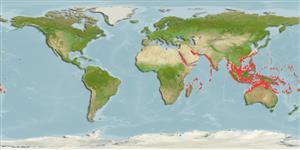Common names from other countries
Environment: milieu / climate zone / depth range / distribution range
Ecologia
marino associati a barriera corallina; distribuzione batimetrica 25 - 147 m (Ref. 5222). Tropical; 30°N - 22°S, 32°E - 173°W (Ref. 5222)
Indo-Pacific: Red Sea, Zanzibar, Maldives, St. Brandon's Shoals, Sri Lanka, Chagos, Nazareth Bank, Sumatra, and Fiji. Recently recorded from Tonga (Ref. 53797). Subspecies, Plectropomus pessuliferus marisburi occurs in the Red Sea, while Plectropomus pessuliferus pessuliferus from the rest of the Indo-Pacific region (Ref. 3150). Often misidentified as Plectropomus maculatus.
Length at first maturity / Size / Peso / Age
Maturity: Lm ?, range 63 - ? cm
Max length : 120 cm TL maschio/sesso non determinato; (Ref. 5222)
Spine dorsali (totale) : 7 - 8; Raggi dorsali molli (totale) : 10 - 12; Spine anali: 3; Raggi anali molli: 8.
An uncommon species (Ref. 9710) found in shallow lagoon and seaward reefs. In the Hong Kong live fish markets (Ref. 27253). Solitary (Ref 90102).
Life cycle and mating behavior
Maturities | Riproduzione | Spawnings | Egg(s) | Fecundities | Larve
Heemstra, P.C. and J.E. Randall, 1993. FAO Species Catalogue. Vol. 16. Groupers of the world (family Serranidae, subfamily Epinephelinae). An annotated and illustrated catalogue of the grouper, rockcod, hind, coral grouper and lyretail species known to date. Rome: FAO. FAO Fish. Synop. 125(16):382 p. (Ref. 5222)
IUCN Red List Status (Ref. 130435)
CITES (Ref. 128078)
Not Evaluated
Threat to humans
Harmless
Human uses
Pesca: commerciale; Pesce da pesca sportiva: si
Strumenti
Special reports
Download XML
Fonti Internet
Estimates based on models
Preferred temperature (Ref.
115969): 22.9 - 28.4, mean 27.1 (based on 672 cells).
Phylogenetic diversity index (Ref.
82804): PD
50 = 0.5078 [Uniqueness, from 0.5 = low to 2.0 = high].
Bayesian length-weight: a=0.01148 (0.00558 - 0.02364), b=3.04 (2.88 - 3.20), in cm Total Length, based on LWR estimates for this (Sub)family-body shape (Ref.
93245).
Trophic level (Ref.
69278): 4.2 ±0.7 se; based on size and trophs of closest relatives
Resilienza (Ref.
120179): Basso, tempo minimo di raddoppiamento della popolazione 4.5 - 14 anni (Tmax=19).
Fishing Vulnerability (Ref.
59153): High vulnerability (58 of 100).
Climate Vulnerability (Ref.
125649): Very high vulnerability (81 of 100).
